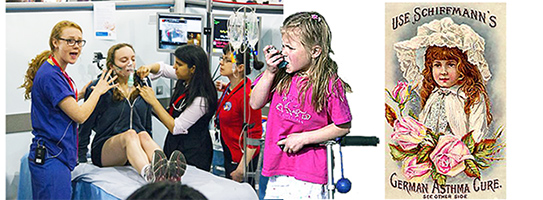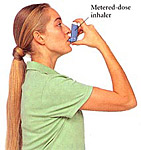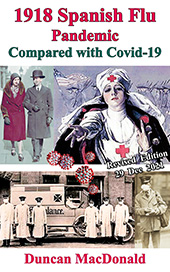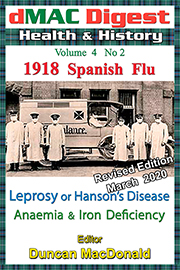Duncan MacDonald
Jakarta 18 May 2006
What is Asthma?

Normal bronchiole Asthmatic bronchiole Women using a Metered-dose inhaler
Intermittent narrowing of the airways, causing shortness of breath and wheezing. The cause is twitchy lung tube muscles with swelling of the tube lining and the production of sticky mucus that strings out on Kleenex like tapioca
Severe asthma attacks are potentially life-threatening if they not given immediate medical treatment.
Asthma attacks range from an occasionally mild occurrence to severe disabling symptoms on most days. Most people experience symptoms between these two extremes.
Asthma Facts
In the past 20 years asthma has become more prevalent in all developed countries. In the UK asthma cases and deaths have doubled since mid-1980 for reasons that are unclear. It affects about 1 in 5 adults and 1 in 7 children. Each year there are more than 85,000 admissions to hospital for treatment of asthma and about 100,000 people attend outpatient treatment [1]
Australia has 2.2 million asthma sufferers with the 3rd highest prevalence of childhood asthma in the world. 397 people died of asthma in 2002. Approximately 60% of asthma deaths are preventable [2]

History The word asthma is derived from the Greek aazein, meaning "sharp breath." or “panting”. The word first appears in Homer's Iliad; Hippocrates was the first to use it in reference to the medical condition. Hippocrates thought that the spasms associated with asthma were more likely to occur in tailors, anglers, and metalworkers.
The use of bronchodilators started in 1901, but it was not until the 1960s that the inflammatory component of asthma was recognized, and anti-inflammatory medications were added to the regimen. Recent research has demonstrated that hookworm infestation protects against asthma (and hay fever).
Exposure to industrial pollutants like sulfur dioxide during thermal inversions makes all kinds of asthma worse but possibly can cause asthma newly in people without lung disease. Smoking does the same thing.
Baker's asthma caused by reaction to wheat flour is one of a family of occupational asthmas including woodworkers, photographers, metal workers, solderers, farmers, plasticiser's, and printer's asthma. A weekend free of asthma suggests occupational asthma. This is less obvious in hobby workers asthma.[3]
Asthma in children Asthma is the leading reason children visit hospital. It is more likely to affect boys (15%) than girls (12%). However adult women suffer more than males.

Asthma is the most common chronic respiratory disease of childhood throughout the world and its prevalence has been increasing in epidemic proportions world-wide.
Schools may be underestimating the prevalence of asthma among their young students. A recent survey by Thomas Jefferson University, Philadelphia, showed students themselves all too often ignore their symptoms and don't realize they have asthma
In this survey 3,300 children were screened for asthma. Approximately 25% reported having the disease and 35% had asthma symptoms. Yet half of these children were not aware of having asthma.
Asthma is among the leading causes of absenteeism. A follow up survey of 2 of the 12 middle schools in Philadelphia showed 43% of high absentees showed symptoms and were diagnosed with asthma. This is statistically significant.[4]
Childhood asthma and pollution Scientist studying air pollution levels in 10 Southern California cities found that the closer children lived to a freeway, the greater their chances of having been diagnosed with asthma.
Researchers also found that children who had higher levels of nitrogen dioxide or NO2, in the air around their homes were more likely to have developed asthma. NO2 is a product of pollutants emitted from combustion engines, such as those in cars and trucks. For each increase of 5.7 parts per billion in average CO2 – from low to high pollution levels among Southern California cities – the risk of asthmas increased by 83%.[5]
Asthma and athletics

USA team for 1996 Summer Olympic Games Skiers at 2014 Sochi Winter Olympics
Regular physical activity is part of good asthma management. However exercise can trigger asthma if not properly managed.
Asthma appears to be more prevalent in athletes than in the general population. A survey of the USA team participating in the 1996 Summer Olympic Games showed that 15% had been diagnosed with asthma, and that 10% were on asthma medication. The prevalence in winter games is likely to be much higher.
These statistics have been questioned on at least two bases. Persons with mild asthma may be more likely to be diagnosed with the condition than others because even subtle symptoms may interfere with their performance and lead to pursuit of a diagnosis. It has also been suggested that some professional athletes who do not suffer from asthma, claim to do so in order to obtain special permits to use certain performance-enhancing drugs.
There appears to be a relatively high incidence of asthma in sports such as cycling, mountain biking, and long-distance running and a relatively lower incidence in weight-lifting and diving. It is unclear how much of these disparities are from the effects of training in the sport, and from self-selection of sports that may appear to minimize the triggering of asthma.
In addition, there exists a variant of asthma called exercise-induced asthma that shares many features with allergic asthma. It may occur either independently, or concurrent with the latter. Exercise studies may be helpful in diagnosing and assessing this condition. [6]
A Norwegian survey found the risk for chronic bronchitis and asthma symptoms was elevated among outdoor workers, but not among regular recreational cross-country skiers. [7]
However Swedish cross country skiers suffer more from exercise induced asthma than their Norwegian cousins. This may be explained by the fact that Swedish winter daytime maximum temperatures average -20ºc to -10ºc which is some 10ºc colder than in Norway.[8]
Doctors used to puzzle why children got exercise-induced asthma much more than adults. Research revealed that the majority of adults don’t exercise or play as children do.
Increased breathing during exercise causes cooling and drying of the lining of the air passages, which can trigger exercise-induced asthma. This explains why warm moist air protects against exercise-induced asthma and why swimming is better exercise for an asthmatic than running, biking or skiing. Some cross-country skiers wear breathing masks which store some body heat and moisture from the air they breathe out and return it to the air they breathe in.
Swimmers are fortunate that, particularly in indoor pools, the air is surrounding them is moist and warm.[9] Asthma Management
There are over 300 environmental triggers that may induce an asthma attack. Of the 300, there are five frequently found in homes;

Dust Mite Second-hand smoke Furry animal pets Mold
- Secondhand Smoke Asthma can be triggered by the smoke from the burning end of a cigarette, pipe or cigar as well as smoke breathed out by a smoker. Eliminate secondhand smoke. Do not smoke in the car; do not smoke around a person with asthma
- Dust Mites: Although too small to be seen with the naked eye, dust mites are found in every home. They live in mattresses, pillows, bedcovers, carpets, fabric covered furniture, clothes and stuffed toys. Eliminate dust mites by using impermeable mattress and pillow covers; wash bedding each week in hot water; dust and vacuum frequently; wash stuffed toys.
- Rodents and Cockroaches: Droppings or body parts of pests can be asthma triggers. Eliminate pests; do not leave food or water out; clean the house; store food in airtight containers; take out garbage regularly; use pesticides only as a last resort.
Mold: Molds grow in damp areas so the key is moisture control. Eliminate mold; control moisture (fix leaks); if mold or mildew is on a non-porous item, wash it with a mild bleach and water solution; if mold is on a porous items, throw it out.- Pets: A pet's skin flakes, urine and saliva can be asthmas triggers. Reduce exposure to pets; keep pets outside; keep them out of bedroom and off furniture; bathe pets regularly; use air filters.
Asthma Remedies Some people with asthma do not need any treatment if they manage to avoid the factors that trigger their symptoms. However there are so many triggers, it is very difficult to avoid them all. Therefore treatment is often necessary.
Today asthma attacks can usually be treated with short-acting reliever drugs, usually bronchodilators. The aim of all drug treatment is to eliminate symptoms and reduce frequency of and severity of the asthma attacks.
 In addition, long-term maintenance treatment may be provided by preventers such as corticosteroid drugs and taken daily. Both relievers and preventers are usually inhaled from a special device called a metered-dose inhaler, or puffer, which delivers a fixed dose of the drug.
Milk Myths The National Asthma Council has warned parents who have removed dairyfoods from their child's diet due tofears that they will act as asthmas triggers, are inadvertently placing their children at risk of developing osteoporosis and malnutrition
In addition, long-term maintenance treatment may be provided by preventers such as corticosteroid drugs and taken daily. Both relievers and preventers are usually inhaled from a special device called a metered-dose inhaler, or puffer, which delivers a fixed dose of the drug.
Milk Myths The National Asthma Council has warned parents who have removed dairyfoods from their child's diet due tofears that they will act as asthmas triggers, are inadvertently placing their children at risk of developing osteoporosis and malnutrition
There is a common view that people with asthma should avoid milk and other dairy products because they are said to promote the production of mucus and hence trigger asthma attacks. This perception dates back more than 2000 years.
According to the According to the National Asthma Council, it is very rare for dairy food to trigger an asthma attack
Genuine allergies to cow's milk are caused by a milk protein and generally lead to gastrointestinal symptoms, rather than respiratory difficulties.
When milk is consumed it temporarily thickens saliva in the mouth, a sensation that many people mistake for respiratory mucus production. There is no clinical evidence to suggest that reducing or stopping consumption of milk or dairy products, will help relieve symptoms of asthma.

Heidi Klum - got milk ad. 2011
CONCLUSION
The single most important aspect of controlling asthma is the careful and planned use of drug treatments. However there are several things you can do to reduce the risk of an attack and decrease the severity of symptoms.
- Do not smoke and try to avoid polluted or smoky atmospheres.
- Take regular exercise to improve your stamina. Swimming is beneficial. Avoid exercise outside when it is cold.
- Avoid substances that are likely to provoke an attack. Do not keep furry animals as pets.
- Always carry an inhaler (or puffer) and be sure to take your medication on holidays.
- If your attacks are triggered by stress, try to practice relaxation exercises such as yoga

In spite of this encouraging outlook, more than 1,600 people [10] in the UK die from severe asthma attacks each year. In most cases the cause of death is a delay in recognizing the severity of the attack, and consequently a delay in getting to hospital
Life's Like That

This Digest article can be downloaded as a FREE e-book on Smashwords.
Available on iPad / iBooks, Kindle, Nook, Sony, & most e-reading apps including Stanza & Aldiko.
Just click the following link
>> download free e-book dMAC Digest






